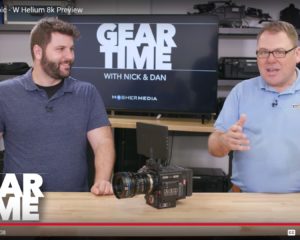Retro Gear Time : U-matic Tape
U-better check this out! On this week’s Retro Gear Time, we go even further back than last week, to one of the progenitors of all videotape: Sony U-matic. Nick and Dan also take a look at some of the rare edit stations for U-matic tape still in use today.
Welcome to Retro Gear Time. Last week, we talked about the Betacam SP tape. This week, we have a different tape format. Let’s get into it.
It’s Sony’s U-matic tape format. A robust piece of media if there ever was one. It’s a 60 minute tape of 640×480 SD video. When it was introduced by Sony back in the late 60s to early 70s, it was a truly revolutionary tape format for TV broadcast and corporate video production.
In terms of quality, U-matic’s successor, Betacam SP, was a better quality tape, and smaller and lighter at that. Of course, they’re all still analog, but how nice this is to have these sitting on your tape shelf…! When you want to watch a video, you just pull it off of your library of masters.
Unfortunately, the setup we have doesn’t work today, being 30 years old. Compared to the media we have now, though, having a shelf of big, labelled tapes is markedly different from hard drives, or very easy to lose SD cards! Copying videos, you would just take it off the shelf, connect it to another machine, and copy it. Yes, you’d also lose a little bit of quality every time you copy it, but only a little bit!
The tape deck I used back in 1998 was the 5800 series, and the Sony RM 450 editing controller. It was at the little TV station in Kent, Ohio that I worked at when I was in high school, learning how to edit. I thought this was pretty much the coolest edit system that had ever been created, and, literally, all you could do with these two tape decks was source deck outs and cuts on this very basic system. The funny thing is, I called out to the station and asked them if I could borrow it, because I thought for sure that stuff is probably in storage. Nope! They are still using that edit system today. I would challenge anyone to find another 3/4 inch edit system still in use in America today. They have probably the last Sony RM 450 and 9800 series U-matic player in working order.
The thing about editing with these pieces of equipment is you’re only doing linear editing. That means that if you make a cut, you’re committed to it. You’re stuck. You can’t go back! Without erasing over things, you cannot go back and change the edit. It’s like building a brick wall; you can’t take a brick out from the base- You’re done.
We’re glad technology has moved on a bit from then, though. We’ll catch you on the next one!


